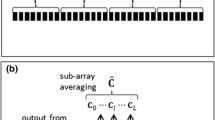Abstract
Background
The adaptive amplitude and phase estimator (APES) has been introduced in medical ultrasound imaging to calculate the amplitude of the desired signal more robustly than other adaptive beamformers like minimum variance (MV). This beamformer minimizes the optimization problem of MV by replacing the estimated array covariance matrix by the interferences plus noise covariance matrix. On the other hand, the Wiener postfilter as a post-weighting factor, which will be multiplied to the final weight vector of the beamformer, estimates the power of the desired signal and the power of the interferences plus noise to improve the contrast.
Method
The proposed method is a combination of the APES beamformer with the Wiener postfilter which uses the capabilities of the APES beamformer for accurate estimation of the amplitude of the desired signal and the Wiener postfilter in suppressing sidelobes. Specifically, we used the interferences plus the noise covariance matrix estimated in the APES beamformer to obtain an APES-based Wiener postfilter and obtained the APES + Wiener weight vector by multiplying the APES-based Wiener postfilter to the standard APES weight vector.
Results
To evaluate the proposed APES + Wiener beamformer, we tested the proposed method on simulated and experimental datasets. The results of a simulated wire phantom demonstrate that the proposed beamformer can resolve two point scatterers better than the standard APES beamformer, even if the points are placed near each other. Simulating a cyst phantom shows that the APES + Wiener beamformer improves the contrast of the resulting images by about 4.5 dB by estimating the interior of the cyst better than the standard APES.
Conclusion
The evaluation of the proposed beamformer on an experimental dataset confirms the results of simulations, in which the proposed beamformer improves the resolution and contrast in comparison with the standard APES beamformer.





Similar content being viewed by others
References
Parker K. Apodization and windowing functions. IEEE Trans Ultrason Ferroelectr Freq Control. 2013;60:1263–1271.
Mann JA, Walker WF. A constrained adaptive beamformer for medical ultrasound: initial results. Proceed IEEE Ultrason Symp. 2002;2:1807–1810.
Sasso M, Cohen-Bacrie C. Medical ultrasound imaging using the fully adaptive beamformer. ICASSP IEEE Int Conf Acoust Speech Signal Process Proceed. 2005;2:II489–ll492.
Capon J. High-resolution frequency-wavenumber spectrum analysis. Proceed IEEE. 1969;57:1408–1418.
Synnevag JF, Austeng A, Holm S. Adaptive beamforming applied to medical ultrasound imaging. Ultrason Ferroelectr Freq Control IEEE Trans. 2007;54:1606–1613.
Synnevag JF, Austeng A, Holm S. Benefits of minimum-variance beamforming in medical ultrasound imaging. Ultrason Ferroelectr Freq Control IEEE Trans. 2009;56:1868–1879.
Asl BM, Mahloojifar A. Eigenspace-based minimum variance beamforming applied to medical ultrasound imaging. Ultrason Ferroelectr Freq Control IEEE Trans. 2010;57:2381–2390.
Asl BM, Mahloojifar A. Contrast enhancement and robustness improvement of adaptive ultrasound imaging using forward-backward minimum variance beamforming. Ultrason Ferroelectr Freq Control IEEE Trans. 2011;58:858–867.
Asl BM, Mahloojifar A. Minimum variance beamforming combined with adaptive coherence weighting applied to medical ultrasound imaging. Ultrason Ferroelectr Freq Control IEEE Trans. 2009;56:1923.
Li PC, Li M-L. Adaptive imaging using the generalized coherence factor. Ultrason Ferroelectr Freq Control IEEE Trans. 2003;50:128–141.
Nilsen CC, Holm S. Wiener beamforming and the coherence factor in ultrasound imaging. Ultrason Ferroelectr Freq Control IEEE Trans. 2010;57:1329–1346.
Shan TJ, Kailath T. Adaptive Beamforming for coherent signals and interference. IEEE Trans Acoust Speech Signal Process ASSP. 1985;33:527–536.
Takao K, Kikuma N. An adaptive array utilizing an adaptive spatial averaging technique for multipath environments. IEEE Trans Antennas Propag AP. 1987;35:1389–1396.
Taki H, Taki K, Sakamoto T, Yamakawa M, Shiina T, Kudo M, Sato T. High range resolution ultrasonographic vascular imaging using frequency domain interferometry with the Capon method. IEEE Trans Med Imaging. 2012;31:417–429.
Stoica P, Li H, Li J. A new derivation of the apes filter. Signal Process Lett IEEE. 1999;6:205–206.
Blomberg A, Austeng A, Hansen R. Adaptive beamforming applied to a cylindrical sonar array using an interpolated array transformation. Ocean Eng IEEE J. 2012;37:25–34.
Trees HLV. Optimum array processing. USA: Wiley; 2002.
Jensen J. Field: a program for simulating ultrasound systems. Med Biol Eng Comput. 1996;34:351–353.
Wagner R, Smith S, Sandrik J, Lopez H. Statistics of speckle in ultrasound B-scans sonics and ultrasonics. IEEE Trans. 1983;30:156–163.
U.-M. Biomedical Ultrasonics Laboratory, North Campus. http://www.bme.umich.edu/labs/bul/newBULsite/.
Author information
Authors and Affiliations
Corresponding author
Ethics declarations
Conflict of interest
There is no conflict of interest in this paper.
Ethical considerations
This article does not contain any studies with human or animal subjects performed by any of the authors.
About this article
Cite this article
Deylami, A.M., Asl, B.M. Amplitude and phase estimator combined with the Wiener postfilter for medical ultrasound imaging. J Med Ultrasonics 43, 11–18 (2016). https://doi.org/10.1007/s10396-015-0671-z
Received:
Accepted:
Published:
Issue Date:
DOI: https://doi.org/10.1007/s10396-015-0671-z




